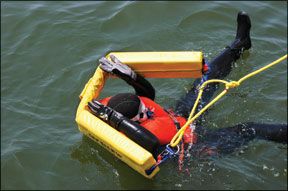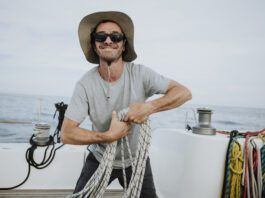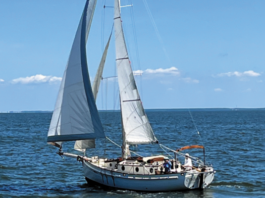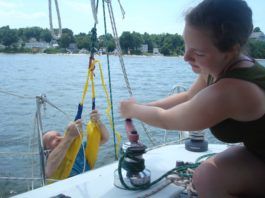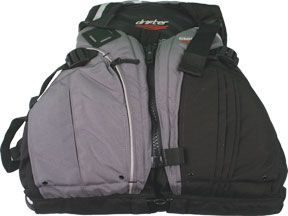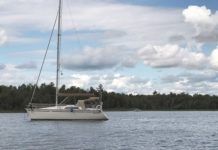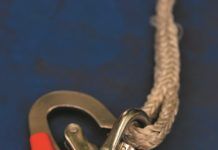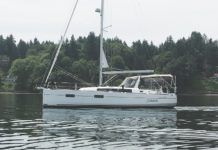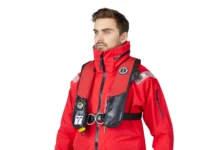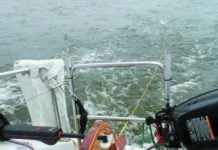Mailport: oil filters, cabin fans, Catalina 22, Hunter 30, watermakers
With regards to your recent marine oil filter tests (see PS July 2019, Marine Oil Filter Comparison Test), having spent my career in the aeronautical engine technical field specializing in maintenance I must state my allegiance to non-encapsulated filters and independent housings. This trend towards spin-on filter assemblies prevents in my opinion the most important aspect of filter maintenance which is particle inspection. Filters are not removed so you can inspect or replace them, they are removed so you can ascertain your engines condition. This practice seems to have been set aside to make way to quick and easy maintenance using spin-on filters. Oil analysis is fine but it should start with a simple sediment inspection after a low cost electro- sonic cleaning in a 60 Hz bath (jewelry cleaner bath).
Tether Lanyard Simplifies MOB Recovery
For years, safety advocates have touted the use of a four-part block and tackle attached to the end of the boom as the hoist of choice. It affords a great dockside demo, but put to use in a rolling seaway, a crew quickly notes that boat motion causes the boom to flail about and the hurriedly dropped mainsail further complicates using the boom as a hoisting tool.
Mailport: anchoring etiquette, stern-tied boats, and wind generators
I really appreciated the article Anchoring in Crowded Harbors (see Practical Sailor, June 2019). The difficult and critical part is always estimating distances, and the guides you gave (two-to-three mast heights, using fractions of a nautical mile, etc.) can be difficult to do accurately in a crowded harbor with the sun setting, with some of that information available only at the helm, and multiple boats moving to anchor. As a bow hunter, I am…
Inflatable PFDs: Know the Ins and Outs
Some sad news this past weekend from the 2018 Chicago-Mackinac race prompted me to update, and repost this advisory from 2015 regarding the care and use of personal flotation devices. It's a relatively long post, but if you depend on inflatable PFD, the text and accompanying links are worth reviewing.
Inflatable PFDs Wont Save You Without Proper Care and Use
I recently interviewed Mark Bologna of Landfall Navigation. Hes a safety expert, major supporter of safety training and has decades worth of experience selecting and servicing inflatable PFDs. The first thing I asked Mark was whether or not I was overly concerned about the inflatable lifejacket issues mentioned above. His unequivocal No, and follow up advocacy for training and regular gear inspections paralleled most of the opinions above.
Rethinking the Use of Inflatable PFDs
In the early 1800s Norwegian sailors started wearing cork filled vests dubbed the Seamans Friend. And over the next two centuries, life jacket design and the materials used have continued to evolve. One of the most promising offshoots has been the inflatable personal flotation device (PFD)-invented and patented by Peter Markus and one thats drawn our interest for over three decades.
Cold Water Survival
When we read about a sailor lost overboard in the storm, we think about PFDs and personal locator beacons, and accept the sea is unforgiving. When we read of novice boaters drowning in a local lake, were sad, but say that will not happen us because we wear PFDs. But when we read of a PFD-equipped sailor falling overboard and dying within minutes its a real eye-opener.
The DYI “Last Chance” Self-rescue Line
Most sailors are familiar with Thor Heyedrahls adventures aboard his balsa raft Kon Tiki. Some may remember the self-rescue line that they dragged behind the boat. Since the raft travelled so slowly, this last chance line gave a fit sailor a sporting chance to haul himself aboard.
Solo Sailor Safety
Is an auto-inflate PFD the right answer for solo offshore cruisers?
Leg Straps Put the Load on Fanny
Considering the short comings of existing leg loops for harnesses, we designed an add-on set of leg loops that can transform any ISO 12401 chest harness into a harness capable of safely distributing the force of a epic fall, without adding significant weight and without inhibiting wearer moment.































